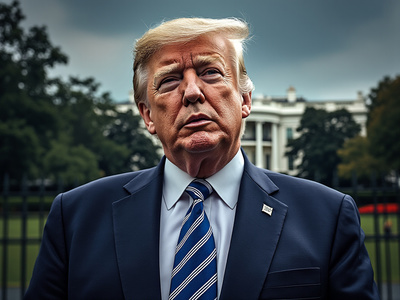
Advisors to Trump Consider 20% Tariffs on Most Imports
The proposed tariffs may be announced as part of Donald Trump's 'LIBERATION DAY', with potential implications for international trade and the Latin American steel industry.
Advisors within the Trump administration are reportedly evaluating a plan to impose tariffs of approximately 20% on most imports into the United States, as has been reported.
This announcement is anticipated to be made by Donald Trump as part of what is being termed ‘LIBERATION DAY’.
Officials are also considering whether to use the projected revenue from these tariffs to fund a tax reduction or to provide dividends to a majority of Americans.
However, planning around this measure remains highly preliminary.
Previously, Trump hinted that the tariffs could be 'reciprocal', reflecting the tariffs imposed by other countries on U.S. exports, suggesting a selective approach rather than a universal tariff structure.
The White House Press Secretary, Karoline Leavitt, stated that the president would unveil a tariff plan aimed at reversing unfair trade practices that have adversely impacted the U.S. for decades.
In the wake of these potential tariff announcements, significant concern has arisen regarding their potential impact on the steel industry in Latin America.
The largest steel producer in Chile, Huachipato, ceased operations in 2024, affected by low-cost steel imports from China.
The implementation of the proposed tariffs could jeopardize approximately 1.4 million jobs in the steel industry across Latin America.
The U.S. currently imports around 25 million tons of steel annually, with Canada serving as the largest individual supplier, followed by Brazil and Mexico.
These imported products are vital for various industries, including automotive and construction.
As highlighted by Ezequiel Tavernelli, the executive director of the Latin American Steel Association (Alacero), the U.S. industry requires specific products with specialized technologies, traditionally sourced from Latin America.
Given the global overproduction of steel, particularly from China, these tariffs could create significant market distortions.
Tavernelli expressed concerns that the introduction of tariffs would likely lead to a flood of redirected steel from the United States to less protected markets in regions such as Latin America, where industry players have limited defenses against such surges in Chinese imports.
Statistics indicate that in 2000, China exported less than 100,000 tons of steel annually to Latin America, a figure that has since escalated to over 14 million tons.
The decline in steel production throughout Latin America has been significant, with production falling by 3.6% in 2024 to 56 million tons against a consumption requirement of 73 million tons.
With the global steel production capacity currently at 2.48 billion tons annually, China is responsible for over 1.14 billion tons, comprising more than 45% of worldwide production.
China not only has high production capabilities but also exports excess steel at dumping prices, enabled by official subsidies.
Notably, 23% of the globe's excess steel production is attributed to China.
The impact of these dynamics was felt acutely in September of the previous year when Huachipato shut down its operations, marking the end of nearly 75 years of steel production.
In response to these challenges, Alacero has advocated for a regional integration of production chains, emphasizing reliance on steel from North and South American neighbors as a defense strategy against unfair trade practices by China and Southeast Asian countries.
Brazilian officials have noted economic complementarity in negotiations aimed at mitigating the proposed tariffs, a strategy that had previously succeeded during Trump's first presidential term.
The Mexican National Chamber of Iron and Steel Industry (Canacero) has underscored the importance of regional productive integration in light of the current threats posed by excess Chinese capacity.
Furthermore, the Argentine Steel Chamber (CAA) has acknowledged the necessity for coordinated responses to counter the competition from Chinese steel manufacturing while emphasizing collaborative solutions among American nations to protect their industries.
This announcement is anticipated to be made by Donald Trump as part of what is being termed ‘LIBERATION DAY’.
Officials are also considering whether to use the projected revenue from these tariffs to fund a tax reduction or to provide dividends to a majority of Americans.
However, planning around this measure remains highly preliminary.
Previously, Trump hinted that the tariffs could be 'reciprocal', reflecting the tariffs imposed by other countries on U.S. exports, suggesting a selective approach rather than a universal tariff structure.
The White House Press Secretary, Karoline Leavitt, stated that the president would unveil a tariff plan aimed at reversing unfair trade practices that have adversely impacted the U.S. for decades.
In the wake of these potential tariff announcements, significant concern has arisen regarding their potential impact on the steel industry in Latin America.
The largest steel producer in Chile, Huachipato, ceased operations in 2024, affected by low-cost steel imports from China.
The implementation of the proposed tariffs could jeopardize approximately 1.4 million jobs in the steel industry across Latin America.
The U.S. currently imports around 25 million tons of steel annually, with Canada serving as the largest individual supplier, followed by Brazil and Mexico.
These imported products are vital for various industries, including automotive and construction.
As highlighted by Ezequiel Tavernelli, the executive director of the Latin American Steel Association (Alacero), the U.S. industry requires specific products with specialized technologies, traditionally sourced from Latin America.
Given the global overproduction of steel, particularly from China, these tariffs could create significant market distortions.
Tavernelli expressed concerns that the introduction of tariffs would likely lead to a flood of redirected steel from the United States to less protected markets in regions such as Latin America, where industry players have limited defenses against such surges in Chinese imports.
Statistics indicate that in 2000, China exported less than 100,000 tons of steel annually to Latin America, a figure that has since escalated to over 14 million tons.
The decline in steel production throughout Latin America has been significant, with production falling by 3.6% in 2024 to 56 million tons against a consumption requirement of 73 million tons.
With the global steel production capacity currently at 2.48 billion tons annually, China is responsible for over 1.14 billion tons, comprising more than 45% of worldwide production.
China not only has high production capabilities but also exports excess steel at dumping prices, enabled by official subsidies.
Notably, 23% of the globe's excess steel production is attributed to China.
The impact of these dynamics was felt acutely in September of the previous year when Huachipato shut down its operations, marking the end of nearly 75 years of steel production.
In response to these challenges, Alacero has advocated for a regional integration of production chains, emphasizing reliance on steel from North and South American neighbors as a defense strategy against unfair trade practices by China and Southeast Asian countries.
Brazilian officials have noted economic complementarity in negotiations aimed at mitigating the proposed tariffs, a strategy that had previously succeeded during Trump's first presidential term.
The Mexican National Chamber of Iron and Steel Industry (Canacero) has underscored the importance of regional productive integration in light of the current threats posed by excess Chinese capacity.
Furthermore, the Argentine Steel Chamber (CAA) has acknowledged the necessity for coordinated responses to counter the competition from Chinese steel manufacturing while emphasizing collaborative solutions among American nations to protect their industries.











